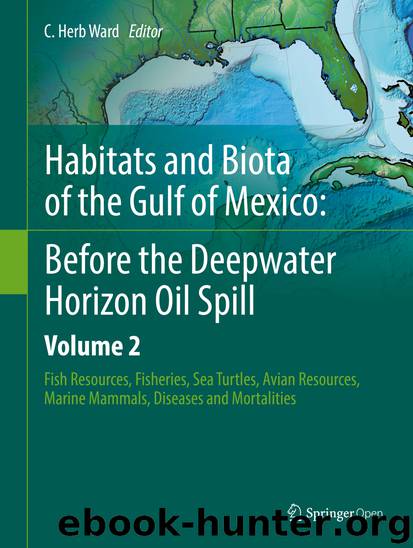Habitats and Biota of the Gulf of Mexico: Before the Deepwater Horizon Oil Spill by C. Herb Ward

Author:C. Herb Ward
Language: eng
Format: epub
Publisher: Springer New York, New York, NY
Historically, severe freezes in the late 1800s are thought to have contributed to the decline in the green turtle fishery in Texas (Hildebrand 1982). More recently, juvenile green turtles, and to a lesser extent Kemp’s ridleys, loggerheads, and hawksbills were hypothermic stunned and stranded in Texas inshore waters during severe winters in 1971, 1979, 1983, and 1989 (Hildebrand 1982; Shaver 1990b). During a severe cold front in February 1989, 46 sea turtles were found stranded as a result of hypothermic stunning in Laguna Madre near Port Mansfield, Texas (Shaver 1990b; Figure 11.48); the hypothermic-stunned turtles included 45 green turtles (31 were found dead) and one dead loggerhead. Hypothermic-stunning events occurred in Port Isabel and South Padre Island, Texas during the winters of 2007 and 2010, in which 150 and 200 green turtles, respectively, were hypothermic stunned (Figure 11.48).
During late December 2000 and early January 2001, an unprecedented hypothermic-stunning event occurred in St. Joseph Bay along the Florida Gulf coast (Foley et al. 2007). More than 400 turtles were hypothermic stunned, which included 388 green turtles (55 found dead) (Figure 11.48), ten Kemp’s ridleys (four found dead), and three loggerhead sea turtles (one found dead) (Foley et al. 2007; McMichael et al. 2008). All of the hypothermic-stunned green turtles were neritic juveniles, and most were from the Florida and Yucatán populations (Foley et al. 2007). The 10 Kemp’s ridleys ranged in size from 26.5 to 46 cm (10.4 to 18.1 in) SCL, with an average SCL of 33.4 cm (13.1 in), and one of the four Kemp’s ridleys found dead was a head-started turtle from the 1998 year class. Most (337 of 401) of the sea turtles survived and were later released (Foley et al. 2007). The rehabilitated and released sea turtles included 329 green turtles, six Kemp’s ridleys, and two loggerheads.
In 2003, a small hypothermic-stunning event occurred in St. Joseph Bay (McMichael et al. 2003, 2008). Forty-two turtles (39 green turtles, two Kemp’s ridleys, and one loggerhead) were hypothermic stunned (Figure 11.48), and 30 of the sea turtles survived. In January 2008, another moderate hypothermic-stunning event occurred in St. Joseph Bay in which more than 100 sea turtles, mostly green turtles, were hypothermic stunned (Roberts et al. 2014).
During January 2010, Florida experienced below freezing temperatures for 12 consecutive days, resulting in a hypothermic-stunning event in St. Joseph Bay of unprecedented magnitude (Avens et al. 2012). A total of 1,733 sea turtles (mostly green sea turtles) were hypothermic stunned. While the majority of the 1,670 green turtles that were hypothermic stunned survived, 434 green turtles died from the hypothermic-stunning event (Avens et al. 2012). Air temperatures below 10 °C along with strong winds were responsible for the mass hypothermic stunning event, in which some of the turtles died when water temperatures remained between 5 and 6 °C for 3 days or so (Roberts et al. 2014; Figure 11.49).
Figure 11.49Air and water temperatures in relation to hypothermic stunned green sea turtles in Saint Joseph Bay, FL in January of 2010. The horizontal
Download
This site does not store any files on its server. We only index and link to content provided by other sites. Please contact the content providers to delete copyright contents if any and email us, we'll remove relevant links or contents immediately.
| Cell Biology | Developmental Biology |
| Entomology | Marine Biology |
| Microbiology | Molecular Biology |
| Biostatistics |
Sapiens: A Brief History of Humankind by Yuval Noah Harari(13040)
The Tidewater Tales by John Barth(12026)
Do No Harm Stories of Life, Death and Brain Surgery by Henry Marsh(6332)
Mastermind: How to Think Like Sherlock Holmes by Maria Konnikova(6225)
The Thirst by Nesbo Jo(5778)
Why We Sleep: Unlocking the Power of Sleep and Dreams by Matthew Walker(5637)
Sapiens by Yuval Noah Harari(4531)
Life 3.0: Being Human in the Age of Artificial Intelligence by Tegmark Max(4493)
The Longevity Diet by Valter Longo(4444)
The Rules Do Not Apply by Ariel Levy(3897)
The Immortal Life of Henrietta Lacks by Rebecca Skloot(3820)
The Body: A Guide for Occupants by Bill Bryson(3789)
Why We Sleep by Matthew Walker(3767)
Animal Frequency by Melissa Alvarez(3750)
Yoga Anatomy by Kaminoff Leslie(3696)
Barron's AP Biology by Goldberg M.S. Deborah T(3629)
The Hacking of the American Mind by Robert H. Lustig(3575)
All Creatures Great and Small by James Herriot(3506)
Yoga Anatomy by Leslie Kaminoff & Amy Matthews(3392)
